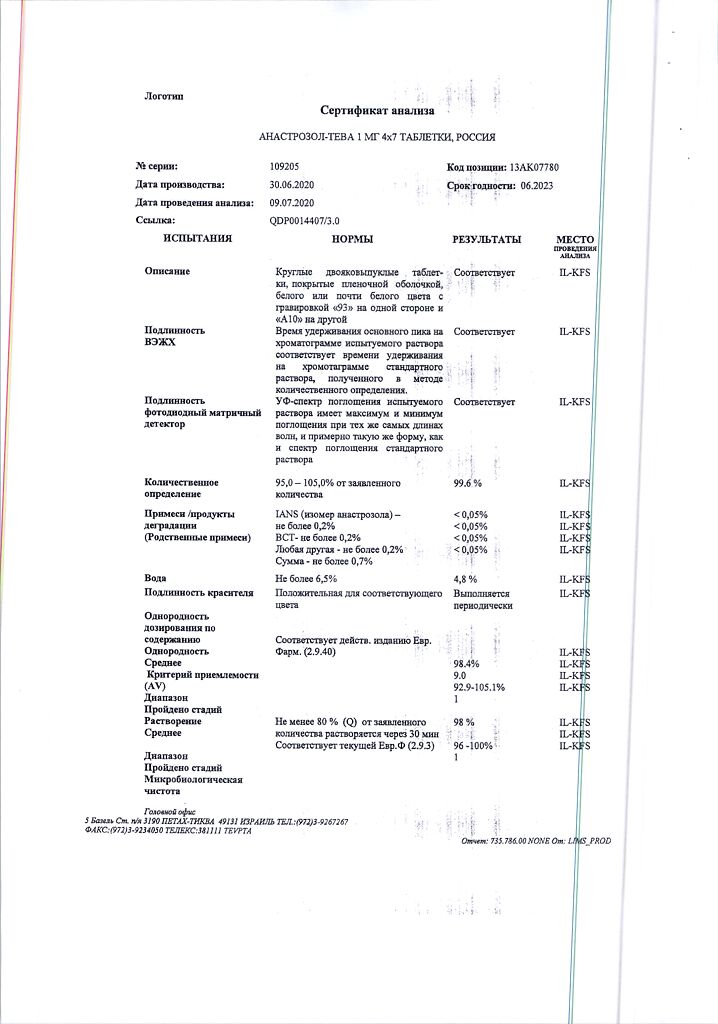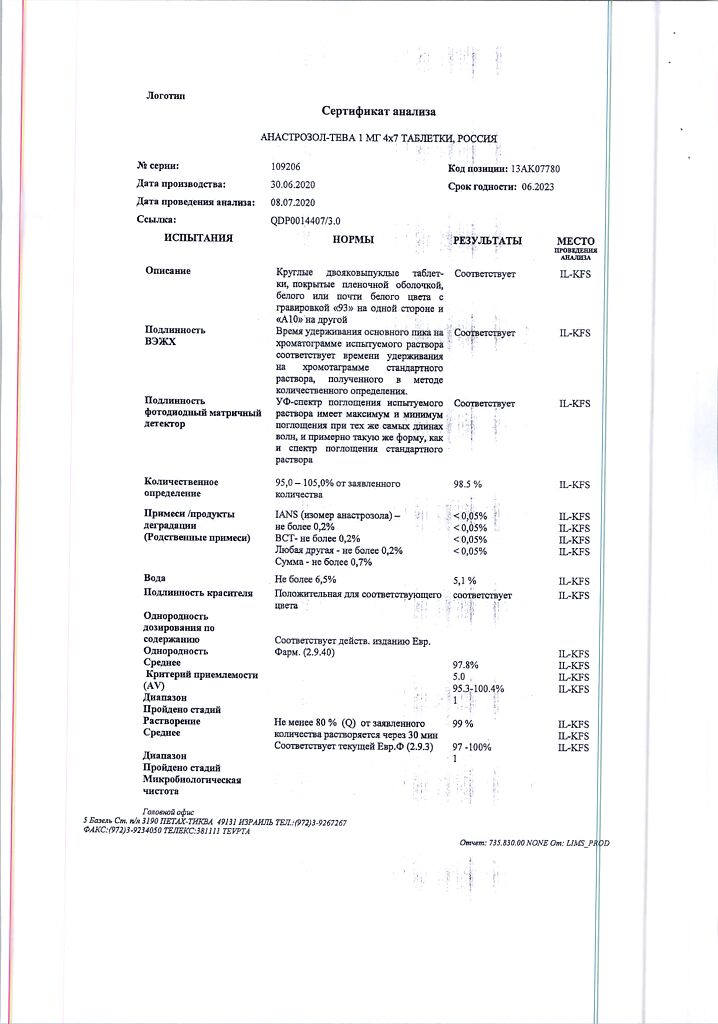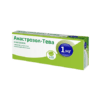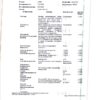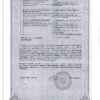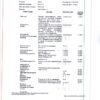No products in the cart.
Description
Pharmacodynamics
Anastrozole is an antitumor drug, an inhibitor of estrogen synthesis.
Anastrozole is a highly selective nonsteroidal aromatase inhibitor, an enzyme by which, in postmenopausal women, androstenedione is converted in peripheral tissues to estrone and then to estradiol. Reducing the concentration of circulating estradiol in patients with breast cancer has a therapeutic effect. In postmenopausal women, anastrozole at a daily dose of 1 mg causes a decrease in estradiol concentrations by 80%.
Anastrozole has no gestagenic, androgenic and estrogenic activity. In daily doses up to 10 mg it has no effect on cortisol and aldosterone secretion, therefore, corticosteroid replacement administration is not required when using anastrozole.
Pharmacokinetics
Intake and distribution
Anastrozole is rapidly absorbed from the gastrointestinal tract after oral administration. Cmax in plasma is usually reached within 2 h after oral administration (fasting). Food slightly reduces the rate of absorption but not its degree and does not result in a clinically significant effect on plasma Css of the drug in a single daily dose of anastrozole.
After 7 days of administration, approximately 90-95% of the plasma Css of anastrozole is achieved. There are no data on the time or dose dependence of the pharmacokinetic parameters of anastrozole. Binding to plasma proteins is 40%.
Metabolism and excretion
Anastrozole is extensively metabolized in postmenopausal women, with less than 10% excreted unchanged by the kidneys within 72 hours after drug administration. T1/2 of anastrozole from blood plasma is 40-50 h. Metabolism of anastrozole is by N-dealkylation, hydroxylation and glucuronidation. Metabolites of anastrozole are excreted mainly by the kidneys. The main metabolite of anastrozole is triazole, which is determined in blood plasma, has no pharmacological activity.
Pharmacokinetics in special clinical cases
The pharmacokinetics of anastrozole are independent of age in postmenopausal women.
The clearance of anastrozole after oral administration is not altered in cirrhosis or impaired renal function.
Indications
Indications
Adjuvant therapy for early hormone receptor-positive breast cancer in postmenopausal women, including after adjuvant therapy with tamoxifen for 2-3 years.
Active ingredient
Active ingredient
Composition
Composition
How to take, the dosage
How to take, the dosage
Ingestion. The tablet should be swallowed whole with water. It is recommended to take the drug at the same time regardless of meals.
Adults, including the elderly: 1 mg orally once daily for a long time. If there are signs of disease progression, the drug should be discontinued. As adjuvant therapy, the recommended duration of treatment is 5 years.
Kidney function disorders:Dose adjustment is not required in patients with impaired renal function.
Hepatic disorders:Dose adjustment in patients with mild to moderate hepatic impairment is not required.
Interaction
Interaction
Studies on drug interactions with phenazone and cimetidine indicate that co-administration of anastrozole with other drugs is unlikely to result in clinically significant cytochrome P450-mediated drug interactions.
There are no clinically significant drug interactions when anastrozole is taken concomitantly with other commonly prescribed drugs.
There is currently no information about the use of anastrozole in combination with other anticancer drugs.
The drugs containing estrogens reduce the pharmacological effects of anastrozole, so they should not be prescribed concomitantly with anastrozole.
Tamoxifen should not be used at the same time as anastrozole, because it may decrease the pharmacologic effects of the latter.
Special Instructions
Special Instructions
In case of doubts about a patient’s hormonal status, menopause should be confirmed by determining the concentration of sex hormones in the blood serum. If uterine bleeding persists while taking anastrozole, a gynecologist should be consulted and monitored.
There are no data on the use of anastrozole in patients with severe hepatic impairment.
In patients with osteoporosis or who are at increased risk of osteoporosis the bone mineral density should be assessed by densitometry, such as DEXA (dual-energy X-ray absorptiometry), at the start of treatment and regularly throughout treatment. Treatment or prophylaxis for osteoporosis should be prescribed as needed, and the patient’s condition should be closely monitored. Because anastrozole reduces circulating estradiol concentrations, it may lead to a decrease in bone mineral density. There are insufficient data to date regarding the beneficial effects of bisphosphonates on anastrozole-induced loss of bone mineral density or their benefit when used for prophylaxis.
There are no data on concomitant use of anastrozole and GnRH analogues.
In women with estrogen receptor-negative tumors, the efficacy of anastrozole has not been demonstrated unless there was a previous positive clinical response to tamoxifen.
Oestrogen-containing medications should not be administered concomitantly with anastrozole, because these medications would negate its pharmacological effect.
The efficacy and safety of anastrozole and tamoxifen when used concomitantly, regardless of hormone receptor status, is comparable to that of tamoxifen alone. The exact mechanism of this phenomenon is not yet known.
It is not known whether anastrozole improves treatment outcomes when used together with chemotherapy.
Impact on ability to drive vehicles and other mechanisms requiring high concentration
Some adverse reactions of anastrozole, such as asthenia and somnolence, may adversely affect the ability to perform potentially hazardous activities requiring high concentration and rapid psychomotor reactions. In this regard, it is recommended to exercise caution when driving vehicles and mechanisms in case of the appearance of these symptoms.
Synopsis
Synopsis
Contraindications
Contraindications
The drug.
Efficacy not established.)
has not been established.)
Cautions
Osteoporosis, hypercholesterolemia, coronary heart disease, hepatic impairment, severe renal failure (creatinine clearance less than 20 ml/min).
Side effects
Side effects
The frequency of adverse reactions below was determined according to the following criteria: very common (at least 1/10); common (more than 1/100, less than 1/10), infrequent (more than 1/1000, less than 1/100), rare (more than 1/10000, less than 1/1000); very rare (less than 1/10000), including individual reports.
Vascular side: very often – “rushes” of blood to the face.
Skeletal, muscular and connective tissue: very common – arthralgia/joint stiffness, arthritis; frequent – bone pain, myalgia; infrequent – trigger finger.
On the genital and mammary glands: frequently – vaginal mucosal dryness, vaginal bleeding (mostly during the first weeks after withdrawal or change of prior hormone therapy to anastrozole).
Skin and subcutaneous tissue: very common – skin rash; common – thinning of hair, alopecia, allergic reactions; infrequent – urticaria; rare – erythema multiforme, anaphylactoid reaction, cutaneous vasculitis (including individual cases of purpura (Schoenlein-Genoch syndrome)); very rare – Stevens-Johnson syndrome, angioedema.
Gastrointestinal tract: very often – nausea; often – diarrhea, vomiting.
Hepatic and biliary tract disorders: often – increased activity of alkaline phosphatase, alanine aminotransferase, aspartate aminotransferase; infrequent – increased activity of gamma-glutamyl transferase and bilirubin concentration, hepatitis.
Nervous system disorders: very common – headache; common – somnolence, carpal tunnel syndrome (mainly observed in patients with risk factors for this disease), sensitivity disorders (including paresthesia, loss or perversion of taste).
Metabolism and nutrition:often – anorexia, hypercholesterolemia; infrequently – hypercalcemia (with/without increased concentration of parathormone). Administration of anastrozole may cause a decrease in bone mineral density due to a decrease in circulating estradiol concentrations, thereby increasing the risk of osteoporosis and bone fractures.
General disorders: very often mild to moderate asthenia.
Unwanted phenomena noted in clinical studies not related to anastrozole administration: anemia, constipation, dyspepsia, back pain, abdominal pain, increased blood pressure, weight gain, depression, insomnia, dizziness, anxiety, paresthesias.
Overdose
Overdose
Pregnancy use
Pregnancy use
The drug is contraindicated in pregnancy and lactation.
Additional information
| Weight | 0.025 kg |
|---|---|
| Shelf life | 3 years. Do not use after the expiration date printed on the package. |
| Conditions of storage | List B. At the temperature not more than 25oC. Keep out of reach of children. |
| Manufacturer | Teva Pharmaceutical Enterprises Ltd, Israel |
| Medication form | pills |
| Brand | Teva Pharmaceutical Enterprises Ltd |
Related products
Buy Anastrozol-Teva, 1 mg 28 pcs with delivery to USA, UK, Europe and over 120 other countries.


